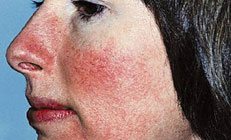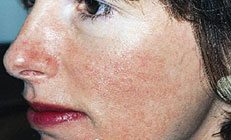Often referred to as adult acne, rosacea causes redness and swelling on the face. This common skin disease may begin as a tendency to flush or blush easily and then progress to persistent redness in the center of the face. This redness may gradually involve the cheeks, forehead, chin and nose, and possibly the ears, chest and back. As the disease progresses, small blood vessels and tiny pimples begin to appear on and around the reddened area. While the exact cause of this skin disease is unknown, Cedar Valley ASCENT and Dr. David J. Congdon, a Mayo Clinic-trained skin care specialist, offer a variety of rosacea treatments, including in-office and at-home methods that can help you reduce rosacea symptoms and control the disease.
Rosacea
Treatment Steps for Controlling Rosacea
For many rosacea sufferers, treatment means identifying symptoms and controlling signs of the disease, a process that varies for each patient depending on his or her condition. With recurring bouts of rosacea common, patients must be vigilant in monitoring their symptoms and signs and communicating with their providers so treatments can be modified as needed. Cedar Valley ASCENT can help treat rosacea in the following ways:
- IPL Photofacial
- Application of exact energy and light wavelengths affects underlying vessels to provide skin clearing.
- Topical treatments
- To alleviate redness, patients may be prescribed a topical gel to restrict blood flow after regular application.
- PCA SKIN® Clinical Care Products
- These advanced products combine all-natural ingredients that are bio-compatible and can help you avoid rosacea.
- Prescription-strength medicine
- Oral antibiotics and acne medication are all methods of reducing rosacea flare-ups.
How to Prevent Rosacea
Because the exact cause of rosacea is unknown, the best prevention is to avoid things that make the face red or flushed. Tips include:
- Avoiding hot drinks, spicy foods, caffeine and alcoholic beverages
- Avoiding sun exposure by staying in the shade between 10 a.m. and 4 p.m. when the sun is most intense
- Avoiding rubbing, scrubbing or massaging the face
- Keeping a diary of flushing episodes and noting associated foods, products, activities, medications or other triggering factors
Case Study
To treat this patient’s rosacea, four IPL treatments were utilized.

Before
